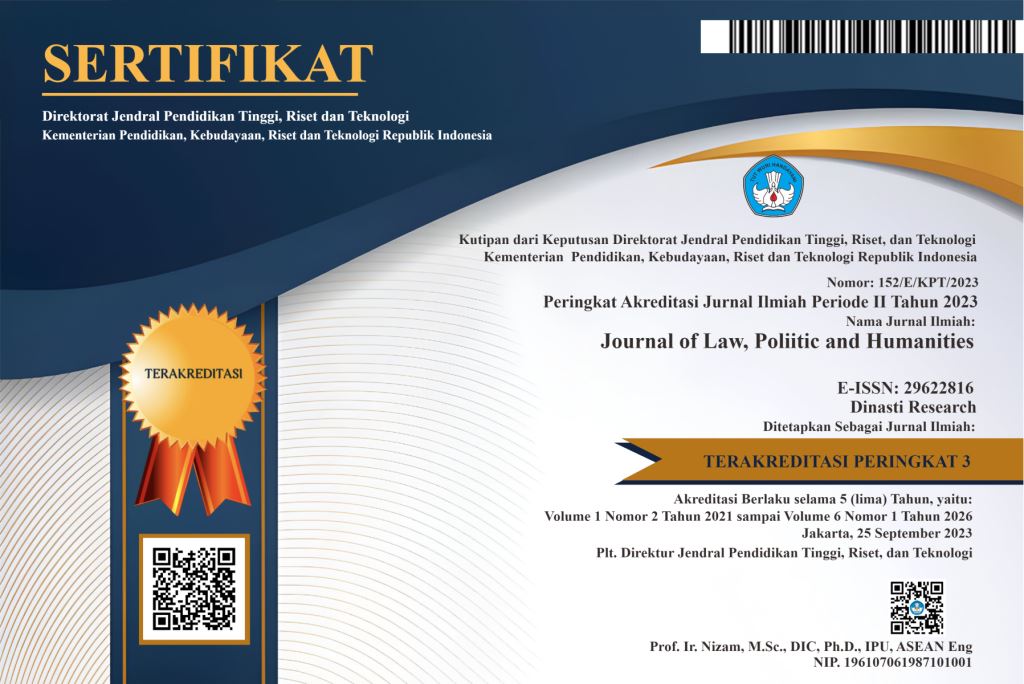The Impacts And Challenges Emanating As Consequence From The “Black, Grey, And White (BGW) List” On Port State Control In The Asia-Pacific Region
DOI:
https://doi.org/10.38035/jlph.v4i6.587Keywords:
Port State Control, Flag State Control, Recognized Organizations, Competency.Abstract
This study aims to describe the understanding of the flag-state administration, recognized organizations, and seafarers onboard regarding the implementation of the port State control for dealing with the impacts and challenges resulting from the results of inspections by port State control. The research relies on qualitative analysis. The primary data was obtained from personal experience and informal discussions with Port State Control Officers (PSCO) of Indonesia and related parties to this research. The secondary data was gathered from National regulations relating to the ratification of IMO conventions, the annual port State control reports in the Asia-Pacific region, publications of organization, sources of documentation, journal references, and various works and literature supporting this research's objectives. The ultimate responsibility of keeping the ship in compliance with international standards lies with the shipowner, flag States, and other relevant industry players. The "Black, Grey, and White List" is the driving force for the shipowners and flag State to encourage them to improve their performance. The goal of every flag State should be to appear high up on the list as possible. For example, the ship flags with a consistently low detention record by port State control will be on the White list. The flag state on the White list means meeting its obligation to register safe and seaworthy ships. It also puts the client at minimal risk of operational difficulties. It makes registering vessels with such flag status of interest to shipping associations to recommend that shipping companies or shipowners choose the appropriate flag.
References
Annual Report on Port State Control in The Asia-Pacific Region, 2018 – 2022, Tokyo MOU.
Carlsson, F. (2016), Classification Societies Acting on Behalf of States. Oslo: University of Oslo. https://www.duo.uio.no/bitstream/handle/10852/51495/5503.pdf?sequence=1.
El Ashmawy, M. E. (2012). The maritime industry and the human element phenomenon. Proc. The 13th Annual General Assembly of the IAMU.
Emad, G., & Roth, W. M. (2008). Contradictions in the practices of training for and assessment of competency: A case study from the maritime domain. Education + Training, 50(3), 260-272.
Ghosh, S., Bowles, M., Ranmuthugala, D., Brooks, B. (2016). Authentic assessment in seafarer education: using literature review to investigate its validity and reliability through rubrics. WMU J Marit Affairs (2016) 15:317–336. P.317. DOI: https://doi.org/10.1007/s13437-015-0094-0.
Ghosh, S., Bowles, M., Ranmuthugala, D., Brooks, B. (2015). Reviewing seafarer assessment methods to determine the need for authentic assessment, Australian Journal of Maritime & Ocean Affairs, DOI: 10.1080/18366503.2014.888133.
Guidelines for authorization of organizations acting on behalf of the Administration, Assembly Resolution A.739 (18), adopted on 4 November 1993, IMO. http://www.sjofartsverket.se/upload/5121/739.pdf.
Goh, L.-B. (2014). A way forward for ship classification and technical services. The Asian journal of shipping and logistics, 56. https://core.ac.uk/download/pdf/82463229.pdf.
Hare, J. (1994). Flag, Coastal & Port State Control. Sea changes, 16, 57-67.
International Convention on Load Lines, 1966, IMO.
International Convention on Tonnage Measurement of Ships, 1969, IMO.
International Convention for the Prevention of Pollution from Ships, 1973, as modified by the Protocol of 1978 relating thereto, IMO.
International Convention for the Safety of Life at Sea, 1974, as modified by the and its Protocol of 1988 relating thereto, IMO.
International Convention on Standards of Training, Certification and Watchkeeping (STCW) for Seafarers, 1978, IMO.
International Safety Management Code, IMO.
IMO Instruments Implementation Code, Assembly Resolution A.1070 (28), adopted 4 December 2013, IMO. https://docs.imo.org/.
IMO Code for Recognized Organizations (RO Code), Assembly Resolution A.739 (18) adopted 21 June 2013, IMO. https://docs.imo.org/.
Kuo, C. (1998). Managing Ship Safety, London: LLP Reference Publishing.
Lau, Y. Y., & Ng, A. K. (2015). The motivations and expectations of students pursuing maritime education. WMU journal of maritime affairs, 14(2), 313-331.
Mansell, J. N. (2009). The Regulatory Regime for Discharge of Flag State Duties: The Role of Classification Societies.
Mansell, J.N.K (2009). Flag State Responsibility, Historical Development and Contemporary Issues. Berlin: Springer.
Manuel, M. E. (2005). Beyond Rules, Skills and Knowledge: Maritime Education and Training for Optimised Behaviour (Mater Dissertation).
Maritime Labour Convention, 2006, IMO.
Memorandum of Understanding on Port State Control in the Asia-Pacific Region, Tokyo MOU.
Park, J. C. (2012). study on the oversight scheme over recognized organizations under the international instruments. Malmô: World Maritime University. https://commons.wmu.se/cgi/viewcontent.cgi?article=1030&context=all.
Resolution A.1155 (32) Adopted on 15 December 2021, Procedures for Port State Control, 2021, IMO.
Shicheng, Y. (2009). Challenges and Opportunities for Maritime Education and Training: China’s Perspective.
Silos et al. (2013), the role of the Classification Societies in the era of globalization: a case study. https://doi.org/10.1080/03088839.2013.776184.
Specifications on the survey and certification functions of recognized organizations acting on behalf of the Administration. Assembly Resolution A.789 (19), adopted on 23 November 1995, IMO. www.imo.org.
Takei, Y. (2013). Assessing Flag State Performance in Legal Terms: Clarifications of the Margin of Discretion. International Journal of Marine and Coastal Law 28, pp. 97-133.
Tamo Zwinge, Duties of Flag States to Implement and Enforce International Standards and Regulations - And Measures to Counter Their Failure to Do So, Journal of International Business and Law, Vol. 10, Issue 2, Article 5 (2011).
The International Chamber of Shipping (ICS), The International Shipping Federation (ISF), Publications Catalogue 2013, by The Editorial Team, 19 February 2013.
Ulstrup, A. (2001). Port State Control. Unpublished lecture handout, World Maritime University, Malmö, Sweden.
United Nations Convention on the Law of the Sea 1982, UN, (1982).
United Nations Convention on the Conditions for Registration of Ships 1986, UN, (1986).
United Nation. (1998). Duties and obligations of Flag States and Port States. Retrieved March 27, 2001. http://www.un.org/Depts/los/IYO98/Flag_Port_State.htm.
Williamson, H.M. (1996, September). Port State Control. Paper presented at the Fourth Asia/Pacific Port State Control Committee Meeting, New Zealand.
Downloads
Published
How to Cite
Issue
Section
License
Copyright (c) 2024 Ferro Hidayah

This work is licensed under a Creative Commons Attribution 4.0 International License.
Authors who publish their manuscripts in this journal agree to the following conditions:
- The copyright on each article belongs to the author(s).
- The author acknowledges that the Journal of Law, Poliitic and Humanities (JLPH) has the right to be the first to publish with a Creative Commons Attribution 4.0 International license (Attribution 4.0 International (CC BY 4.0).
- Authors can submit articles separately, arrange for the non-exclusive distribution of manuscripts that have been published in this journal into other versions (e.g., sent to the author's institutional repository, publication into books, etc.), by acknowledging that the manuscript has been published for the first time in the Journal of Law, Poliitic and Humanities (JLPH).


























